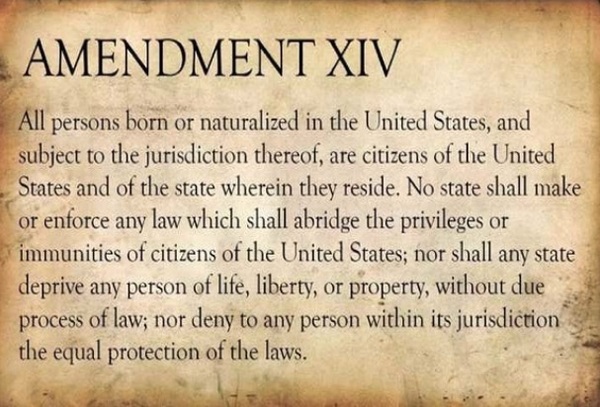
–>
August 3, 2022
E pluribus unum, the traditional motto of the United States, means ‘Out of many, one.’ It asserts that our strength is in assimilation of shared values, goals, and vision. It unifies our diverse races, religions, and other groups by appealing to the ideals of a constitutional republic – freedom, equality, the pursuit of wealth, happiness and excellence through free market competition.
‘); googletag.cmd.push(function () { googletag.display(‘div-gpt-ad-1609268089992-0’); }); }
But the hackneyed shibboleth of the Left – Diversity is our strength – stands in direct contradiction to our original national motto. It serves their destructive aim of Balkanizing us by race, gender, sexual orientation, and other sub-groups du jour. Denigrating and rewriting our history, the Left aims to radically transform our culture: discounting merit, hard work, knowledge and experience, it wants to make identity the ubiquitous sine qua non of representation in American society.
This strategy is reified in the so-called ‘social justice’ components of environmental, social, and governance (ESG) criteria; diversity, equity, and inclusion (DEI) guidelines; and critical race theory (CRT) based programs. Such programs try to cure historical discrimination with more discrimination – in the form of quotas based on race, sex, and other increasingly complicated factors – a disastrous strategy that only intensifies social discord instead of ameliorating it. Under such programs, educational institutions, government, businesses and other employers are forced to sacrifice quality and excellence in favor of a diversity that discriminates de novo and is unconstitutional.
One front in the fightback against such quotas is the Californians for Equal Rights Foundation (CERF) v. Alameda County case, recently brought before the Superior Court of California. It exemplifies the conflict between ‘woke’ rhetoric and the enduring legal framework protecting the rights of all citizens – regardless of race, sex, or national origin. CERF, represented by the non-profit Pacific Legal Foundation, is challenging race-based quotas for awarding contracts, contending that this amounts to using taxpayer funds to promote discrimination.
‘); googletag.cmd.push(function () { googletag.display(‘div-gpt-ad-1609270365559-0’); }); }
Two Alameda County programs – the Construction Compliance Outreach Program of its Public Works Agency (PWA) and the Enhanced Construction Outreach Program of its General Services Agency (GSA) – seek to demonstrate good faith in meeting ostensible “equity” goals through quotas for minority- and women-owned businesses. Of all contracted projects over $100,000, the PWA is required to award 15% to minority business enterprises (MBEs) and 5% to women-owned businesses (WBEs). Similar quotas are required of the GSA in projects over $125,000.
Past legal challenges to racial quotas cited the equal protection clause of the 14th Amendment to the U.S. Constitution and the Civil Rights Act of 1964. The 14th Amendment, ratified after the Civil War, proscribed discrimination against blacks. Central to the protection of civil rights, it guarantees that a government agency will not deny equal protection under the law and that individuals in similar situations will be treated equally under the law. The Civil Rights Act bans employment discrimination on the basis of race, color, religion, sex, or national origin, and guarantees non-discrimination in the distribution of federal funds.

The key point is that, read together, these laws can be seen as prohibiting all discriminatory practices – including quotas that, in the name of affirmative action, privilege members of certain groups and rob other competent individuals of opportunity. It means initiatives like affirmative action must demonstrate a legitimate non-discriminatory objective that cannot be achieved by other means.
But the Equal Employment Opportunity Act of 1972 changed the equation, amending the Civil Rights Act to give the Equal Employment Opportunity commission (EEOC) the ability to influence judicial interpretation of civil rights. It paved the way for affirmative action programs seeking to correct past underutilization of minorities and women. Courts have since been engaged in a debate on whether it is constitutional to make race a deciding factor in university admissions, employment, and government contracting. The following are three important precedent-setting court decisions:
a) Regents of the University of California v. Bakke (1978) was a landmark case. Allan Bakke, a 35-year-old white male, had been rejected twice by the University of California Davis School of Medicine. His admissions score was above average; but for the quota reserving 16 seats out of 100 for racial minorities, he’d have been accepted. The Supreme Court ruled that the quota violated the Equal Protection Clause and the Civil Rights Act. It said there are other ways – instead of a blatant quota system – to improve representation of minorities in the classroom. Excluding a candidate based on his race, it ruled, is discriminatory. The university failed to satisfy the court that there was a compelling need for a quota and that it had exhausted other means to achieve diversity.
b) Coalition for Economic Equity v. Wilson was a challenge to the California Civil Rights Initiative (CCRI) or Proposition 209, overwhelmingly approved by voters in 1996. Although California’s state constitution, Article 1, Section 7, stated that a person may not be denied equal protection under the law, affirmative action programs were using race and other personal characteristics to determine college admissions, public hiring decisions and contract awards. To eliminate such practices, Prop. 209’s approval further strengthened the constitution by amending it to include Section 31. This new provision explicitly prohibited state governmental institutions from considering race, sex, ethnicity or national origin in public employment, public education and public contracting. It essentially put an end to affirmative action programs.
‘); googletag.cmd.push(function () { googletag.display(‘div-gpt-ad-1609268078422-0’); }); } if (publir_show_ads) { document.write(“
The day after Proposition 209 was approved, the American Civil Liberties Union (ACLU) filed the Coalition for Economic Equity v. Wilson case alleging the initiative violated anti-discriminatory laws. Although Prop. 209 was initially ruled a violation of anti-discrimination laws, on appeal, Governor Pete Wilson was victorious, based on the argument that a law furthering anti-discriminatory laws cannot itself be discriminatory.
c) Hi-Voltage Wire Works, Inc. v. City of San Jose was a challenge to a 2000 program to ostensibly eliminate discrimination against minorities and women in city public construction contracts. It required bidders for city projects valued over $50,000 to meet outreach and participation guidelines for subcontractors. Hi-Voltage Wire Works, a general contracting firm, sued the city alleging that the requirements were discriminatory. It won, affirming that programs that exclusively hire minorities or women violate the state constitution, amended by Proposition 209.
Several other courtroom attempts to interpret federal and state equal protection clauses as approving affirmative action have proved unsuccessful. An attempt to annul Proposition 209 with an affirmative action amendment, Proposition 16, was defeated by voters. By abundant precedent, it has been established that preferential treatment based on race, sex, or national origin is unconstitutional. It is also a “remedy” opposed by most constituents. In all likelihood, CFER v. Alameda County will also be decided in favor of equal protection under the law and equal opportunities for all, regardless of race, color or sex.
Historical discrimination cannot be cured with more discrimination – that is, with special set-asides for one group over another. Equality under the law, as enshrined in our statutes, must be preserved, and so must equality of opportunity. Quotas are unjust and jeopardize the exercise of free market competition to promote excellence. In addition, they diminish the targeted population by bringing their competency into question. Sans quotas, would they have been selected as the entity best suited to perform the work in question?
In Fools, Frauds and Firebrands, a 2015 critique of the New Left, Roger Scruton writes that “the goal of ‘social justice’ is no longer equality before the law, or the equal claim to the rights of citizenship, as these were advocated at the time of the Enlightenment. The goal is a comprehensive rearrangement of society….” But isn’t that what the Left wants? E pluribus chaos, a complete inversion of uniquely American ideals that seek unity while respecting diversity.
<!– if(page_width_onload <= 479) { document.write("
“); googletag.cmd.push(function() { googletag.display(‘div-gpt-ad-1345489840937-4’); }); } –> If you experience technical problems, please write to [email protected]
FOLLOW US ON
<!–
–>
<!– _qoptions={ qacct:”p-9bKF-NgTuSFM6″ }; ![]() –> <!—-> <!– var addthis_share = { email_template: “new_template” } –>
–> <!—-> <!– var addthis_share = { email_template: “new_template” } –>





